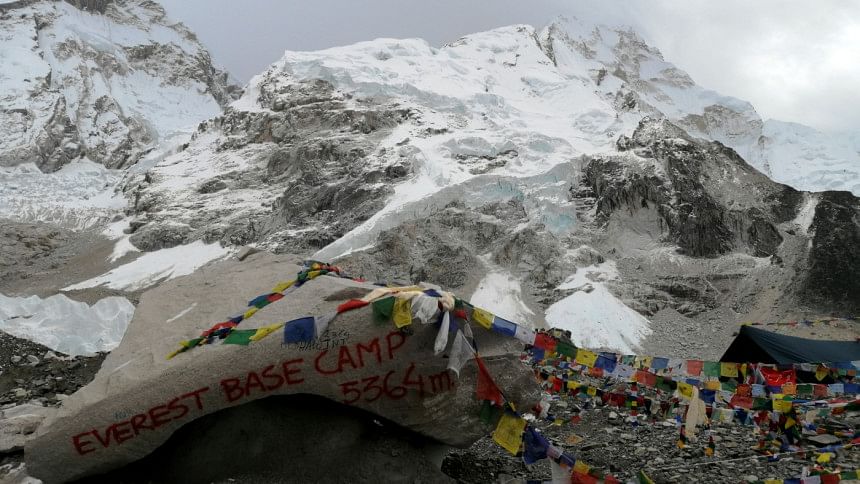Time to open the tourism land route to Nepal

With stunning Himalayan vistas and historic towns on offer, there are few international destinations that can be as attractive to the Bangladeshi tourist as Nepal. Airfare prices to Kathmandu are reasonable. Travel costs inside Nepal are affordable. E-visa and visa-on-arrival arrangements available to Bangladeshi passport holders are convenient. Yet more could be done to increase tourist traffic, for the benefit of both nations.
In the case of India, Bangladeshi tourists account for approximately one-in-five tourist arrivals. By comparison, the Bangladeshi segment of Nepal's tourist arrivals is around 2.2 percent. In 2018, of the almost 1.2 million tourists to visit Nepal, only 26,255 were Bangladeshis. That number was fewer than the number of tourists that had visited the year before.
As Nepal gears up to celebrate its "Visit Nepal 2020" year, and in light of the recent four-day visit to Kathmandu by the Bangladeshi president, Mohammad Abdul Hamid, to discuss trade, transit and tourism, it's an opportune time to look at why the country that at its nearest point is just over 20 kilometres distant from Bangladesh, hasn't been able to entice larger tourist numbers.
In recent times of course, the tragedy of the US-Bangla Airlines plane crash at Kathmandu's Tribhuwan International Airport on March 12, 2018, in which 51 people lost their lives, understandably instilled a sense of trepidation among would-be visitors. This incident might well explain the almost 3,000 fewer Bangladeshi tourists to visit Nepal that year as compared to the year before.
When considering longer term tourist exchange, however, other factors are at play. Perhaps foremost among them is the question of road connectivity.
By road, the distance between the Banglabandha land port in the north-western tip of Bangladesh and the entry point to eastern Nepal across the Siliguri Corridor at Kakarbhitta is around 40 kilometres. Theoretically, such a short distance should make even day trips possible.
But between the two points is India, for which Bangladeshis would need a dual entry transit visa, arranged in advance, to cross the corridor and return. The Nepalese, meanwhile, enjoy visa-free entry to India but need a visa for Bangladesh. It is unavailable at the border. Thus, for a resident of eastern Nepal to visit Bangladesh, they would first need to travel either by air or for around 12 hours by road to Kathmandu, to process their visa. With direct transport, within 12 hours they could reach Dhaka.
In May 2018, under the then Bangladesh, Bhutan, India, Nepal (BBIN) transport agreement, from which Bhutan subsequently withdrew, and to media fanfare in both Bangladesh and Nepal, a trial bus service was run between Dhaka and Kathmandu.
The service was supposed to identify challenges passengers using such a route may face, including visa issues. Unfortunately, the experiment has thus far come to nothing.
Indeed, to maximise the tourism potential for both countries, any bus link would need not only to streamline the visa issues but also provide flexibility for passengers to get on and off the service along the way.
The 2018 bus journey from Dhaka included an impractical overnight stay in Siliguri and took two days to reach Kathmandu. While some passengers may wish to undertake the entirety of such a long journey, particularly in order to avoid flying, many more may wish to travel for shorter distances, such as Dhaka to eastern Nepal, or from Nepal to north-western Bangladesh.
Enabling tourism across these shorter distances could become an economic boon to both the eastern Nepalese region, and to Rangpur and Rajshahi Divisions in Bangladesh.
Of course, alongside the opening of a land route for passengers, better tourism marketing is required. For Bangladeshis, the most famous Nepali destinations are the Kathmandu Valley, Pokhara and Nagarkot in West Nepal. Yet in eastern Nepal there is the chance to take scenic flights over Everest or to visit the base camp. There are ample opportunities for trekking and rafting, as well as the chance to experience local cultures that are unique to the east.
For Nepali tourists to Bangladesh, meanwhile, who thus far are not significant in number, the best-known attractions are Dhaka and, of course, the sea. For just as many Bangladeshis hope to experience the Himalayas, the landlocked Nepalese have a fascination for the coast. With better marketing alongside a smooth transport route, The Nepalese might also be tempted by the highlights of the northwest such as Kantajew Temple, Paharpur and Tajhat Palace.
As living standards in both countries rise, the potential for tourism is growing. For every year that passenger transport across the Siliguri Corridor remains impractical, there is for both Bangladesh and Nepal a loss in tourism revenue. It is a loss made all the more significant for tourism's potential to positively impact the economies of regional areas in both countries.
Birat Anupam is a freelance journalist based in the East Nepali town of Itahari.

 For all latest news, follow The Daily Star's Google News channel.
For all latest news, follow The Daily Star's Google News channel. 



Comments